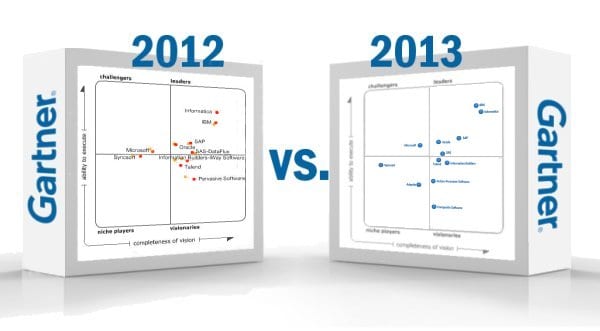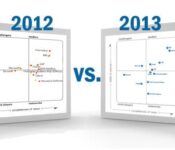2013 Gartner Data Integration Magic Quadrant: What Has Changed Since 2012?

 Never before have companies seen the amount of data they are collecting and housing, and never before have those companies utilized that information to understand their consumers and business process at such a level as they are now. Important tools in utilizing enterprise data are Data Integration solutions tasked with sharing data and information across all organizational and system boundaries to create a frictionless and flexible information infrastructures.
Never before have companies seen the amount of data they are collecting and housing, and never before have those companies utilized that information to understand their consumers and business process at such a level as they are now. Important tools in utilizing enterprise data are Data Integration solutions tasked with sharing data and information across all organizational and system boundaries to create a frictionless and flexible information infrastructures.
As in years past Gartner has attempted to outline the Data Integration market with the release of their Magic Quadrant for Data Integration Tools. Gartner’s evaluation centers on connectivity, modes of interaction (CDC, bulk event), data transformation capabilities, metadata and modeling, design and development, data governance, deployment options, operations and administration, architecture and service enablement. After their evaluation around these criteria for Data Integration it does not seem as though much has changes in the Data Integration space over the past year.
All Data Integration providers that were included in the 2012 Magic Quadrant still remain and there were only to additions to their grouping of leaders, challengers, niche players and visionaries. Adeptia and Composite Software are the two new comers to the 2013 Magic Quadrant. Here is a quick break down of the reasons behind each provider’s inclusion:
Adeptia
Coverage of core capabilities:
- Supports for core requirements in the breadth of connectivity and adapters, bulk/batch data delivery, and granular data capture and propagation.
- Ability to support business personnel’s participation in building and maintaining integration.
- Ease of use.
Integrated product offering:
- Range of data integration functions in a single tool suite.
- Capabilities such as such as data mapping, flow design and shared data definitions across use cases.
Spans both data integration and application integration:
- Adeptia’s EBIM Suite provides a single environment for data integration capability.
- Seamlessly implement multiple integration infrastructures in a synergistic way.
Composite Software
Coverage of core capabilities:
- Use of multitiered caching to enhance both the design and performance of the federation processing was focused specifically on the best approach to optimize when to refresh data from sources (all data has differing refresh rates and thus cache layers do not need to be universally updated at the same time).
Track record and partner channels:
- Efficient partnering network, which includes implementers and other data integration software vendors. HP, Hortonworks, IBM, Infosys, MicroStrategy and Tibco Software.
- Partnerships with Progress Software for Progress Corticon in its business rule management solution and with BMC for a similar solution that provides federation or virtual data access to support heterogeneous data access without requiring point-to-point physical data transformation.
Connectivity support and links to related capabilities:
- Supports connectivity to relational databases, prerelational legacy data types, flat files, XML, packaged application prebuilt access and HDFS.
- Templates/pre-builds for EDI, HL7, SWIFT and various XML dialects are available to accelerate connectivity to these source types.
While the Magic Quadrant “veterans” have shifted within their respective Gartner “labels” IBM, Informatica, SAP, Oracle, SAS, Talend, Information Builder, Actian-Pervasive Software, Microsoft and Syncsort have all remained in their previous quadrants. With that said Vincent McBurney, IBM Information Champion for Information Integration, pointed out a few winners in this years Magic Quadrant and a results of the limited movement within the space. He writes:
“These are the vendors who will be happiest with this latest Quadrant:
- IBM: have made the jump to either First or Equal First depending on how you angle the piece of paper and squint. It is a good year for IBM given that Informatica dropped a bit on Ability to Execute while IBM climbed a lot – more than any other vendor.
- Talend: so close, yet so far. Almost in a Leaders Quadrant for the first tmie they have shown improvement on Ability to Execute and it is only a matter of time before they get there.
- Microsoft had a promising climb as newer versions of data integration software take hold.”
Click here to read more on what McBurney wrote and to access the 2013 Gartner Magic Quadrant for Data Integration Tools.
Widget not in any sidebars

















